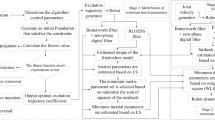Abstract
With the development of modern industrial technologies and intelligent control technology, the requirement for the accuracy of the robot’s terminal attitude is getting higher and higher. Therefore, the technology of kinematics parameter identification, robot calibration becomes more and more important. In order to achieve the accurate calibration of the end position of the robot, it is necessary to identify and analyze its errors in order to improve its accuracy. In this paper, the error model of 6-DOF parallel manipulator is constructed based on vector matrix analysis, and the mapping relationship between attitude error and structural parameter error is obtained. In order to solve the problem that the attitude accuracy of the end of a 6-DOF parallel robot decreases, this paper creatively proposes a genetic algorithm to optimize the accuracy of the 6-DOF parallel robot. At the same time, this paper also improves the genetic algorithm by eliminating the similar individuals in the population of the algorithm through the application of the crowding mechanism, thus avoiding the premature convergence of the genetic algorithm. Finally, the proposed algorithm is compared with the least squares method. The simulation results show that the proposed genetic algorithm-based robot kinematics parameter error identification algorithm has obvious advantages.












Similar content being viewed by others
Explore related subjects
Discover the latest articles, news and stories from top researchers in related subjects.References
Chen TCT (2018) Advanced ambient intelligence system informatics. J Ambient Intell Humaniz Comput 9(2):211–213
Chen MC, Lu SQ, Liu QL (2018) Global regularity for a 2D model of electro-kinetic fluid in a bounded domain. Acta Math Appl Sin Engl Ser 34(2):398–403
El Fissaoui M, Beni-Hssane A, Saadi M (2019) Energy efficient and fault tolerant distributed algorithm for data aggregation in wireless sensor networks. J Ambient Intell Humaniz Comput 10(2):569–578
Fan K, Li Z, Yang C (2018) Robust tube-based predictive control for visual servoing of constrained differential-drive mobile robots. IEEE Trans Ind Electron 65(4):3437–3446
Garcia-Rodriguez R, Parra-Vega V (2017) Normal and tangent force neuro-fuzzy control of a soft-tip robot with unknown kinematics. Eng Appl Artif Intell 65:43–50
Gong D, Peng W, Zhao S et al (2018) Bionic quadruped robot dynamic gait control strategy based on twenty degrees of freedom. IEEE CAA J Autom Sin 5(1):382–388
Ha J, Fagogenis G, Dupont PE (2019) Modeling tube clearance and bounding the effect of friction in concentric tube robot kinematics. IEEE Trans Robot 35(2):353–370
Jha R, Chablat D, Baron L (2018) Influence of design parameters on the singularities and workspace of a 3-R P S parallel robot 1. Trans Can Soc Mech Eng 42(1):30–37
Kagawa T, Ishikawa H, Kato T et al (2017) Optimization-based motion planning in joint space for walking assistance with wearable robot. IEEE Trans Robot 31(2):415–424
Kun W, Bingyin R (2018) A method on dynamic path planning for robotic manipulator autonomous obstacle avoidance based on an improved RRT algorithm. Sensors 18(2):571
Li JC (2011) The error analysis and calibration of a new type of mobile parallel robot. Harbin Institute of Technology, Harbin, pp 17–18
Minati L, Frasca M, Yoshimura N et al (2018) Versatile locomotion control of a hexapod robot using a hierarchical network of nonlinear oscillator circuits. IEEE Access 6:8042–8065
Montazeri A, West C, Monk SD et al (2017) Dynamic modelling and parameter estimation of a hydraulic robot manipulator using a multi-objective genetic algorithm. Int J Control 90(4):661–683
Murooka M, Ueda R, Nozawa S et al (2017) Global planning of whole-body manipulation by humanoid robot based on transition graph of object motion and contact switching. Adv Robot 31(6):322–340
Oh SY, Orin D, Bach M (2010) An inverse kinematic solution for kinematically redundant robot manipulators. J Robot Syst 1(3):235–249
Omisore OM, Han S, Ren L et al (2017) Non-iterative geometric approach for inverse kinematics of redundant lead-module in a radiosurgical snake-like robot. Biomed Eng Online 16(1):93
Park H, Kwak B, Bae J (2018) Inverse kinematics analysis and COG trajectory planning algorithms for stable walking of a quadruped robot with redundant DOFs. J Bionic Eng 15(4):610–622
Sangdani MH, Tavakolpour-Saleh AR, Lotfavar A (2017) Genetic algorithm-based optimal computed torque control of a vision-based tracker robot: simulation and experiment. Eng Appl Artif Intell 67:24–38
Wang H, Gao T, Kinugawa J et al (2017) Finding measurement configurations for accurate robot calibration: validation with a cable-driven robot. IEEE Trans Robot 33(5):1156–1169
Wu Y, Löwe H, Carricato M et al (2017) Inversion symmetry of the euclidean group: theory and application to robot kinematics. IEEE Trans Robot 32(2):312–326
Author information
Authors and Affiliations
Corresponding author
Additional information
Publisher's Note
Springer Nature remains neutral with regard to jurisdictional claims in published maps and institutional affiliations.
Rights and permissions
About this article
Cite this article
Yan, Y. Error recognition of robot kinematics parameters based on genetic algorithms. J Ambient Intell Human Comput 11, 6167–6176 (2020). https://doi.org/10.1007/s12652-020-01781-x
Received:
Accepted:
Published:
Issue Date:
DOI: https://doi.org/10.1007/s12652-020-01781-x




